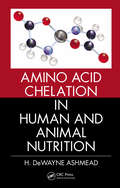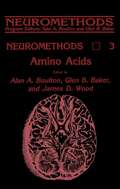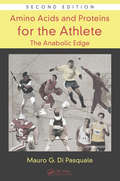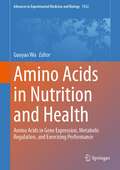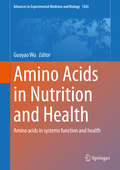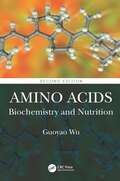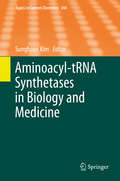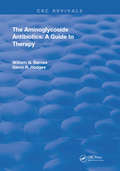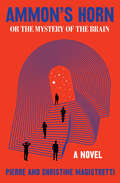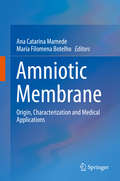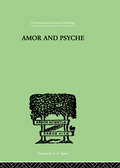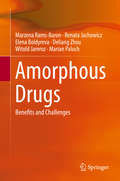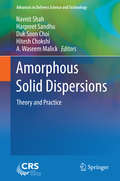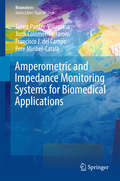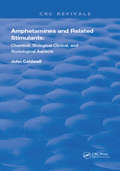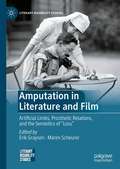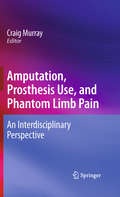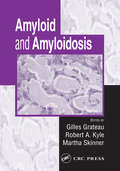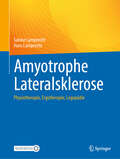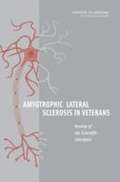- Table View
- List View
Amino Acid Chelation in Human and Animal Nutrition
by H. DeWayne AshmeadAlthough introduction of amino acid chelates in mineral nutrition initially met considerable skepticism and controversy, the greater absorption and bioavailability of amino acid chelated minerals compared to nonchelated minerals have been well-documented for decades. Amino Acid Chelation in Human and Animal Nutrition compiles published chemical, nu
Amino Acids (Neuromethods #3)
by Alan A. Boulton Glen B. Baker James D. WoodThis book is about amino acids.
Amino Acids and Proteins for the Athlete: The Anabolic Edge (Nutrition in Exercise & Sport)
by Mauro G. Di PasqualeExtensively updated with all chapters rewritten and double the information and references, Amino Acids and Proteins for the Athlete: The Anabolic Edge, Second Edition reflects the nearly exponential increase in data and knowledge in the past few years regarding the use of amino acids and proteins to enhance athletic performance. This groundbreaking
Amino Acids in Nutrition and Health: Amino Acids in Gene Expression, Metabolic Regulation, and Exercising Performance (Advances in Experimental Medicine and Biology #1332)
by Guoyao WuThis book explains about amino acids (AAs) which are not only building blocks of protein, but are also signaling molecules as well as regulators of gene expression and the protein phosphorylation cascade. Additionally, AAs are key precursors for syntheses of hormones and low-molecular-weight nitrogenous substances with each having enormous biological importance. For example, physiological concentrations of AA metabolites (e.g., nitric oxide, polyamines, glutathione, taurine, thyroid hormones, and serotonin) are required for cell functions. Growing evidence shows that humans and animals have dietary requirements for all proteinogenic AAs. Mammals, birds, and fish also have species- and age-dependent needs for some AA-related substances. However, elevated levels of other products (e.g., ammonia, homocysteine, H2S, and asymmetric dimethylarginine) are pathogenic factors for neurological disorders, oxidative stress, and cardiovascular disease. Thus, optimal amounts of AAs and their ratios in diets and circulation are crucial for whole-body homeostasis and health. Adequate provision of one or a mixture of functional AAs or metabolites may be beneficial for ameliorating health problems at various stages of the life cycle (e.g., fetal growth restriction, neonatal morbidity and mortality, weaning-associated intestinal dysfunction and wasting syndrome, obesity, diabetes, cardiovascular disease, the metabolic syndrome, and infertility). Dietary supplementation of these nutrients can also optimize the efficiency of metabolic transformations to enhance muscle growth, milk production, and athletic performance, while preventing excess fat deposition and reducing adiposity. Therefore, functional AAs hold great promise in improving the growth, health, and well-being of individuals.
Amino Acids in Nutrition and Health: Amino Acids in the Nutrition of Companion, Zoo and Farm Animals (Advances in Experimental Medicine and Biology #1285)
by Guoyao WuAmino acids (AAs) are not only building blocks of protein, but are also signalling molecules as well as regulators of gene expression and the protein phosphorylation cascade. Additionally, AAs are key precursors for syntheses of hormones and low-molecular weight nitrogenous substances with each having enormous biological importance. For example, physiological concentrations of AA metabolites (e.g., nitric oxide, polyamines, glutathione, taurine, thyroid hormones, and serotonin) are required for cell functions. Growing evidence shows that humans and animals have dietary requirements for all proteinogenic AAs. Mammals, birds and fish also have species- and age-dependent needs for some AA-related substances. However, elevated levels of other products (e.g., ammonia, homocysteine, H2S, and asymmetric dimethylarginine) are pathogenic factors for neurological disorders, oxidative stress, and cardiovascular disease. Thus, optimal amounts of AAs and their ratios in diets and circulation are crucial for whole body homeostasis and health. Adequate provision of one or a mixture of functional AAs or metabolites may be beneficial for ameliorating health problems at various stages of the life cycle (e.g., fetal growth restriction, neonatal morbidity and mortality, weaning-associated intestinal dysfunction and wasting syndrome, obesity, diabetes, cardiovascular disease, the metabolic syndrome, and infertility). Dietary supplementation of these nutrients can also optimize the efficiency of metabolic transformations to enhance muscle growth, milk production, and athletic performance, while preventing excess fat deposition and reducing adiposity. Therefore, functional AAs hold great promise in improving the growth, health and well-being of individuals.Chapter 7 is available open access under a Creative Commons Attribution 4.0 International License via link.springer.com.
Amino Acids in Nutrition and Health: Amino acids in systems function and health (Advances in Experimental Medicine and Biology #1265)
by Guoyao WuThis edited volume comprehensively highlights recent advances in the metabolism, nutrition, physiology, and pathobiology of amino acids in all the systems of humans and other animals (including livestock, poultry, companion animals, and fish). It enables readers to understand the crucial roles of amino acids and their metabolites in the health and diseases of the circulatory, digestive, endocrine, immune, muscular, nervous, reproductive, respiratory, skeletal, and urinary systems, as well as the sense organs (eyes, ears, nose, skin, and tongue). Readers will learn that amino acids are not only the building blocks of protein, but are also signalling molecules, as well as regulators of gene expression, metabolic processes and developmental changes in the body. This knowledge will guide nutritional practices to improve the growth, development and health of humans and other animals, as well as prevent and treat chronic (e.g., obesity, diabetes, and cardiovascular disorders) and infectious (e.g., bacterial, fungal, parasite, and viral) diseases. Editor of this volume is an internationally recognized expert in nutritional biochemistry. He has over 38 years of experience with research and teaching at world-class universities in the area of amino acid biochemistry, nutrition, and physiology. He has published more than 625 papers in peer-reviewed journals, 62 chapters in books, and authored two text/reference books, with an H-index of 117 and more than 55,000 citations in Google Scholar. This publication is a useful reference for professionals as well as undergraduate and graduate students in animal science, biochemistry, biomedical engineering, biology, human medicine, food science, kinesiology, nursing, nutrition, pharmacology, physiology, toxicology, veterinary medicine, and other related disciplines. In addition, all chapters provide general and specific references to amino acids in systems health for researchers and practitioners in biomedicine, animal and plant agriculture, and aquaculture, and for government policy makers.
Amino Acids: Biochemistry and Nutrition
by Guoyao WuFollowing its predecessor, the second edition of Amino Acids: Biochemistry and Nutrition presents exhaustive coverage of amino acids in the nutrition, metabolism and health of humans and other animals. Substantially revised, expanded and updated to reflect scientific advances, this book introduces the basic principles of amino acid biochemistry and nutrition, while highlighting the current knowledge of the field and its future possibilities. The book begins with the basic chemical concepts of amnio acids, peptides and proteins, and their digestion and absorption. Subsequent chapters cover cell-, tissue-, and species-specific synthesis and catabolism of amino acids and related bioactive metabolites, and the use of isotopes to study amino acids metabolism in cells and the body. The book details protein turnover, physiological functions of amino acids, as well as both the regulation and inborn errors of amino acid metabolism. The book concludes with a presentation on human and animal dietary requirements of amino acids and evaluates dietary protein quality. Features: Encompasses a comprehensive coverage of basic to applied concepts in amino acid metabolism in humans and other animals. Highlights important roles of dietary amino acids and protein intake in growth, physical performance and health, including sarcopenia mitigation and immunity. Discusses concerns over the excess intakes of amino acids or protein in the development of diseases, including cardiovascular disorders, diabetes and cancers, as well as bone integrity Each chapter contains select references to provide comprehensive reviews and original experimental data on the topics discussed. Each chapter is backed by original experimental data on various topics discussed and contains select references to aid the reader further in research. Written by Distinguished Professor of Animal Nutrition, Guoyao Wu, Ph.D., this book is an authoritative reference for students and researchers in both biomedicine and agriculture.
Aminoacyl-tRNA Synthetases in Biology and Medicine (Topics in Current Chemistry #344)
by Sunghoon KimThis book will focus on new molecular interactions and novel activities and the associated diseases that have been recently discovered from the studies of eukaryotic and mammalian aminoacyl-tRNA synthetases. In addition, the potential applications of ARS researches in biotechnology and medicine will be addressed.
Aminoglycoside Antibiotics A Guide To Therapy (Routledge Revivals)
by William G. Barnes and Glenn R. HodgesFirst Published in 1984, this book offers a full, comprehensive guide into the applications of Aminoglycoside Antibiotics in therapy. Carefully compiled and filled with a vast repertoire of notes, diagrams, and references this book serves as a useful reference for Students of Medicine, and other practitioners in their respective fields.
Ammon's Horn, or The Mystery of the Brain: A Novel
by Pierre Magistretti Christine MagistrettiFive cutting-edge scientists compete for $100 million and control of a new institute dedicated to eradicating Alzheimer&’s in this edifying, Da Vinci Code-esque thriller.Spurred by his wife&’s Alzheimer&’s diagnosis and disenchanted with the slow progress in finding a cure, a rich Swiss businessman launches a contest for promising young neuroscientists who can think &“outside the box.&” Chosen for their scientific excellence and originality, they must travel throughout Europe in search of the answers to five fiendishly difficult riddles, each combining an enigmatic neuroscientific question with a geographical and historical challenge.As their personal stories unfold, the competitors share their moments of elation and disappointment when they solve a riddle or reach a dead end. Soon a conspiracy materializes to threaten and endanger the scientists, which at first seems random, but then becomes increasingly deliberate and targeted.The nature of the riddles and the talents of the competitors open a world of discovery for us too as we learn about some of the most pressing areas in current brain research, such as neurodegenerative diseases, stem cell grafts, artificial intelligence, drug addiction, genetics, and the mechanisms of memory. And as the candidates visit some of the great European cities—Prague, Vienna, Cordoba, Cambridge, Geneva, Venice—we also experience their beauty and intrigue.
Amniotic Membrane: Origin, Characterization and Medical Applications
by Ana Catarina Mamede Maria Filomena BotelhoThis book describes the human amniotic membrane from its origin, characterization and medical applications, summarizing all the latest developments and findings related to this tissue with contributions from some of the leading researchers in the field. The book addresses issues for its preservation, separation and identification of amniotic membrane-derived cells, as well as the potential ethical issues involved in their use. The topic of this book is particularly pertinent for clinicians and researchers involved in the research and use of this tissue.
Amor And Psyche: THE PSYCHIC DEVELOPMENT OF THE FEMININE (Works By Erich Neumann Ser. #6)
by Neumann, ErichFirst Published in 1999. Routledge is an imprint of Taylor & Francis, an informa company.
Amorphous Drugs: Benefits and Challenges
by Marian Paluch Elena Boldyreva Marzena Rams-Baron Renata Jachowicz Deliang Zhou Witold JamrozThis book explains theoretical and technological aspects of amorphous drug formulations. It is intended for all those wishing to increase their knowledge in the field of amorphous pharmaceuticals. Conversion of crystalline material into the amorphous state, as described in this book, is a way to overcome limited water solubility of drug formulations, in this way enhancing the chemical activity and bioavailability inside the body. <P><P> Written by experts from various fields and backgrounds, the book introduces to fundamental physical aspects (explaining differences between the ordered and the disordered solid states, the enhancement of solubility resulting from drugs amorphization, physical instability and how it can be overcome) as well as preparation and formulation procedures to produce and stabilize amorphous pharmaceuticals. Readers will thus gain a well-funded understanding and find a multi-faceted discussion of the properties and advantages of amorphous drugs and of the challenges in producing and stabilizing them. The book is an ideal source of information for researchers and students as well as professionals engaged in research and development of amorphous pharmaceutical products.
Amorphous Solid Dispersions: Theory and Practice (Advances in Delivery Science and Technology)
by Navnit Shah Harpreet Sandhu Duk Soon Choi Hitesh Chokshi A. Waseem MalickThis volume offers a comprehensive guide on the theory and practice of amorphous solid dispersions (ASD) for handling challenges associated with poorly soluble drugs. In twenty-three inclusive chapters, the book examines thermodynamics and kinetics of the amorphous state and amorphous solid dispersions, ASD technologies, excipients for stabilizing amorphous solid dispersions such as polymers, and ASD manufacturing technologies, including spray drying, hot melt extrusion, fluid bed layering and solvent-controlled micro-precipitation technology (MBP). Each technology is illustrated by specific case studies. In addition, dedicated sections cover analytical tools and technologies for characterization of amorphous solid dispersions, the prediction of long-term stability, and the development of suitable dissolution methods and regulatory aspects. The book also highlights future technologies on the horizon, such as supercritical fluid processing, mesoporous silica, KinetiSol®, and the use of non-salt-forming organic acids and amino acids for the stabilization of amorphous systems. Amorphous Solid Dispersions: Theory and Practice is a valuable reference to pharmaceutical scientists interested in developing bioavailable and therapeutically effective formulations of poorly soluble molecules in order to advance these technologies and develop better medicines for the future.
Amos: To Ride A Dead Horse
by Stanley G. WestSet in the early '60s in a sudden turn of events, Amos survives a tragic accident that kills his wife and leaves him with a shattered hip, without family, and penniless, he is taken to the county poor farm, Sunset Home. Having nothing to live for, Amos believes his life is over and he resolves to let go and die as quickly as possible, isolating himself from the other residents of the poor farm. Under head nurse Daisy Daws's iron rule, Amos witnesses the unthinkable horror by chance in the middle of the night. This reawakens his deeply felt sense of justice and he resolves to live on. He can't let her get away with it.
Amperometric and Impedance Monitoring Systems for Biomedical Applications (Bioanalysis #4)
by Jordi Colomer-Farrarons Jaime Punter-Villagrasa Francisco J. del Campo Pere Miribel-CatalàThe book presents the conception and realization of a pervasive electronic architecture for electrochemical applications, focusing on electronic instrumentation design and device development, particularly in electrochemical Point-of-Care and Lab-on-a-Chip devices, covering examples based on amperometric (DC) and impedance detection (AC) techniques. The presented electronics combine tailored front-end instrumentation and back-end data post-processing, enabling applications in different areas, and across a variety of techniques, analytes, transducers and environments. It addresses how the electronics are designed and implemented with special interest in the flow process: starting from electronic circuits and electrochemical biosensor design to a final validation and implementation for specific applications. Similarly, other important aspects are discussed throughout the book, such as electrochemical techniques, different analytes, targets, electronics reliability and robustness. The book also describes the use of the presented electronics in different electrochemical applications through some examples: instantaneous and non-destructive cellular monitoring and portable glucose monitoring device. Moreover, the book aims to introduce a comprehensive approach to electronic circuits, techniques and electrochemical sensors in POC devices to a general audience of students in biomedical and electronics engineering, scientists, and engineers.
Amphetamines and Related Stimulants: Chemical, Biological, Clinical, and Sociological Aspects (Routledge Revivals)
by John CaldwellFirst published in 1980: The current texts represent the state-of-the-art on the use and abuse of amphetamines and related stimulants, from chemical, pharmacological, clinical, and social aspects.
Amputation in Literature and Film: Artificial Limbs, Prosthetic Relations, and the Semiotics of "Loss" (Literary Disability Studies)
by Maren Scheurer Erik GraysonAmputation in Literature and Film: Artificial Limbs, Prosthetic Relations, and the Semiotics of “Loss” explores the many ways in which literature and film have engaged with the subject of amputation. The scholars featured in this volume draw upon a wide variety of texts, both lesser-known and canonical, across historical periods and language traditions to interrogate the intersections of disability studies with social, political, cultural, and philosophical concerns. Whether focusing on ancient texts by Zhuangzi or Ovid, renaissance drama, folktales collected by the Brothers Grimm, novels or silent film, the chapters in this volume highlight the dialectics of “loss” and “gain” in narratives of amputation to encourage critical dialogue and forge an integrated, embodied understanding of experiences of impairment in which mind and body, metaphor and materiality, theory and politics are considered as interrelated and interacting aspects of disability and ability.
Amputation, Prosthesis Use, and Phantom Limb Pain: An Interdisciplinary Perspective
by Craig MurrayThe book will contain contributions from the fields of anthropology, biomedical engineering, computer science, neuroscience, nursing, prosthetics and orthotics, psychology, and rehabilitative medicine. It will be comprised of three broad interrelated sections. Following an introductory chapter in which the topics and chapters of the book are overviewed, the first section ("Providing and Monitoring the Use of Prostheses") will concentrate on the work of prostheticians and will consist of three chapters. The first of these, written by a clinician responsible for the provision of prosthetics in a large regional area of the UK, will present a range of ethical and medico-legal issues for rehabilitation professionals in the supply and withdrawal of prostheses and assistive technology for people with limb loss or deformity. The second chapter, provided by a prosthetician and prosthetic engineers, will present the development of an innovative computerized technique for monitoring upper limb prosthesis activity. The final chapter in this section is written by an anthropologist, himself an amputee, presenting ethnographic work on how prostheticians and their clients actually "go about" providing artificial limbs. Together these chapters explicate the processes involved in prostheticians' work with clients in a manner which will be of interest to students and professionals from a range of disciplines. Section 2 ("The Experience and Meaning of Prosthesis Use") focuses on the experiences and meanings of prosthesis users themselves. The first of three chapters, written by members of the Dublin Psychoprothetics Group, explores the ways in which people adapt and cope with limb loss and using a prosthesis, the potential for positive adjustment and strengths emerging from the experience, pain, affective distress, issues around identity, body image, and the construction of self and quality of life. It also considers the importance of these issues for health service providers across the multidisciplinary team who work with people with limb loss. The second chapter provides a reflective critique of the themes in the book, namely, the process of prosthetic rehabilitation, by way of a reprint of Gelya Frank's classic paper "Beyond Stigma: Visibility and Self-Empowerment of Persons with Congenital Limb Deficiencies," along with a new commentary from the author herself. This chapter focuses on the experiences of people born with congenital limb deficiencies who have chosen not to use prosthetics as part of a strategy to counteract the stigmatization of disability and bodily difference. The views of these participants provide challenges to a range of professionals involved in the rehabilitation of people with amputations and limb deficiencies. The final chapter of this section presents a range of themes in the experiences of people who choose to use prosthetics following amputation or limb absence, including the embodied used of prosthesis and the integration of these into the identity of the persons concerned. The final section (postoperative pain and new treatments of phantom limb pain) focuses on phantom limb pain and emerging therapies for this phenomenon. The first of four chapters presents a clinician's account of post amputation pain, stressing how this is temporally dependent, varying at different stages of the perioperative/postoperative period, with possibly more than one pain being present at any time. In considering the complex amalgam of pain contributors the author argues for a full biopsychosocial assessment to be made with attention and treatment given to any associated mood disorder, disorder of cognition or behavioral maladaptations. These considerations are developed further in the following chapter where, written from a nursing perspective, the coping style of patients in relation to phantom limb pain are discussed and compared with other pain conditions. The final two chapters in this section present two emerging therapies for phantom limb pain which have received particular academic and media attention. This condition ...
Amyloid and Amyloidosis
by Robert A. Kyle Gilles Grateau Martha SkinnerThis authoritative volume contains 179 chapters by international experts on recent developments in our understanding of amyloid proteins, protein folding disorders, and new and proposed clinical trials in amyloidosis. Topics include detection and characterization techniques; biological functions; genetics; disorders, diagnosis, and treatments, incl
Amyloid and Related Disorders: Surgical Pathology and Clinical Correlations (Current Clinical Pathology)
by Guillermo A. Herrera Ahmet Dogan Maria M. PickenAbnormal proteins are known to be associated with various pathologies. Most notably, these include amyloidoses, monoclonal protein deposits associated with plasma cell dyscrasia/multiple myeloma, cryoglobulins and various related organized and non-organized deposits. Amyloid and Related Disorders presents an overview of the most recent developments in this area including clinical presentation, etiology, pathogenesis, and differential diagnosis. The rationale for various therapies, including transplantation, is discussed and tissue diagnosis (its pitfalls and strategies for avoiding them) and laboratory support are included. The involvement of all major organ systems including renal/genitourinary, cardiac, gastrointestinal, pulmonary, peripheral nerve/central nervous system, soft tissue and bone marrow pathology is covered. This approach provides a unifying concept of these pathologic processes, which have systemic involvement, and which have, hitherto, not been universally appreciated. Awareness of these diseases among a wider audience of pathologists may increase the rate of their diagnosis as well as that of earlier diagnosis. This volume will be invaluable to specialized and general pathologists as well as cytopathologists; other medical professionals may also benefit from this concise update on the systemic amyloidoses.
Amyloidosis and Fabry Disease: A Clinical Guide
by Diane Xavier de Ávila Humberto Villacorta JuniorThis book presents a multispecialty and multidisciplinary approach on Amyloidosis and Fabry disease. These two “rare” diseases are underdiagnosed and have systemic peculiarities that should be emphasized for diagnosis. In both cases, early diagnosis is important for initiating treatment sooner, achieving better prognosis, and improving patients’ quality of life. The history of these patients, in general, involves a long journey among health professionals to obtain a diagnosis. Even after a patient is diagnosed, there are still difficulties in understanding these complex diseases, managing complications, and defining specific treatment. Therefore, this work will be a valuable resource for many healthcare professionals, including physicians of various specialties, nurses, physiotherapists, and medical students. It will also be of interest to patients who would like to understand Amyloidosis and Fabry disease. The content will give healthcare professionals a clinical perspective and provide insights on proper care. Readers will be able to recognize the symptoms related to each disease and will be guided during diagnosis and treatment. Chapters include an overview on clinical course, and will address neurological, ophthalmological, dermatological, gastrointestinal, hematological and cardiology manifestations, orthopedic care, mutations, expressiveness according to epigenetics and multidisciplinary treatment. Chapter authors from around the world will contribute sharing their experience in managing these diseases.
Amyloidosis: Diagnosis and Treatment (Contemporary Hematology)
by Morie A. Gertz S. Vincent RajkumarAn up-to-date reference on this fascinating set of complex disorders, this book features the most comprehensive strategies for diagnosing, classifying, imaging, treating, and managing amyloidosis in multiple organ systems. Beneficial to the spectrum of practitioners from residents to sub-specialists, this book is a succinct authoritative text written by leaders in the field. The authors provide instruction on all forms of amyloidosis - including primary amyloidosis (AL), secondary amyloidosis (AA), and familial amyloidosis. With essential treatment algorithms, Amyloidosis: Diagnosis and Treatment is the gold-standard for all hematologists, oncologists, and internists caring for patients with this complex disease.
Amyotrophe Lateralsklerose: Physiotherapie, Ergotherapie, Logopädie
by Hans Lamprecht Sabine LamprechtDieses Praxisbuch beschreibt alle Aspekte der Behandlung von ALS-Erkrankten in der Physiotherapie, Ergotherapie und Logopädie umfassend. In welcher Intensität ist die Therapie sinnvoll? Wie funktioniert ein Talker? Welche atemtherapeutischen Maßnahmen können unterstützend angewendet werden? Hier finden Sie alle Antworten, um eine optimale Therapie zu gewährleisten. Aus dem Inhalt: Pathophysiologie, Phänotypen und Phasen der ALS, Physiotherapeutische, ergotherapeutische und logopädische Zielsetzungen und Maßnahmen, Medikamente und Hilfsmittelversorgung in den unterschiedlichen Phasen, Dysarthrie und Ernährung, palliative Versorgung im interdisziplinären Team, Plus: Patientenbeispiele und Videos via SN More Media App veranschaulichen die Behandlung optimal.
Amyotrophic Lateral Sclerosis in Veterans: Review of the Scientific Literature
by Institute of Medicine of the National AcademiesThe National Academies Press (NAP)--publisher for the National Academies--publishes more than 200 books a year offering the most authoritative views, definitive information, and groundbreaking recommendations on a wide range of topics in science, engineering, and health. Our books are unique in that they are authored by the nation's leading experts in every scientific field.
